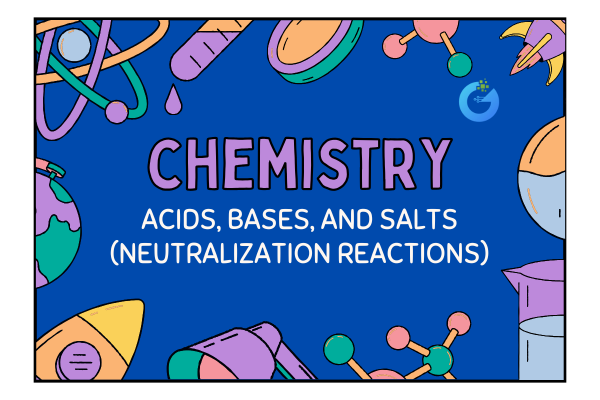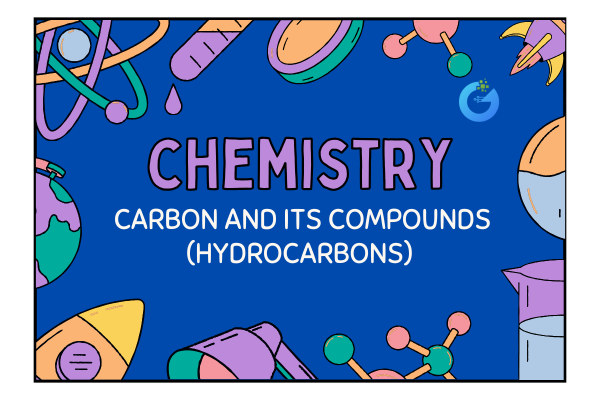Introduction
Have you ever squeezed a lemon and felt your mouth pucker from the sourness? Or applied baking soda paste to soothe a painful insect bite?
These small everyday moments are perfect examples of how chemistry works in real life. The sour taste of lemons, the cleaning power of soaps, the relief from antacids—all come down to one key concept: the behavior of acids, bases, and salts.
In this Class 10 Chemistry chapter, we’ll explore:
- What acids and bases really are
- How they react with each other (neutralization)
- How salts are formed
- Why pH matters in health, hygiene, farming, and industry
So let’s dive in and decode the colorful, reactive world of acids, bases, and salts.
expert-led Chemistry classes – visit our website to learn more
What Are Acids?
Acids are substances that release H⁺ ions (hydrogen ions) when dissolved in water. These ions are what give acids their unique properties.
Common Characteristics of Acids:
- Taste sour (like lemon or vinegar)
- Turn blue litmus paper red
- React with metals to release hydrogen gas (H₂)
- Conduct electricity in solution
- Have a pH less than 7
Common Acids Around You:
| Acid | Found In | Use |
| Hydrochloric acid (HCl) | Stomach | Aids digestion |
| Sulfuric acid (H₂SO₄) | Car batteries | Used in manufacturing |
| Acetic acid (CH₃COOH) | Vinegar | Food preservation |
| Citric acid | Lemons, oranges | Sour taste |
| Carbonic acid (H₂CO₃) | Soft drinks | Fizz and tang |
What Are Bases?
Bases are substances that release OH⁻ ions (hydroxide ions) when dissolved in water. They have their own distinct characteristics.
Common Characteristics of Bases:
- Taste bitter
- Feel soapy or slippery
- Turn red litmus paper blue
- Conduct electricity in solution
- Have a pH greater than 7
Common Bases Around You:
| Base | Found In | Use |
| Sodium hydroxide (NaOH) | Drain cleaners | Soap-making |
| Ammonium hydroxide (NH₄OH) | Window cleaners | Household cleaning |
| Calcium hydroxide (Ca(OH)₂) | Lime water | Soil treatment |
| Magnesium hydroxide | Antacids | Neutralizes stomach acid |
Indicators: How We Identify Acids and Bases
Indicators are substances that change color when added to acidic or basic solutions. They help us test pH quickly and visually.
| Indicator | In Acid | In Base |
| Litmus | Blue → Red | Red → Blue |
| Methyl Orange | Orange → Red | Orange → Yellow |
| Phenolphthalein | Colorless | Pink |
What Is a Neutralization Reaction?
When an acid reacts with a base, they cancel each other’s effect. This is called neutralization.
General Equation:
Acid + Base → Salt + Water
Example:
HCl + NaOH → NaCl + H₂O
(Hydrochloric acid + Sodium hydroxide → Salt + Water)
This process removes the H⁺ from the acid and the OH⁻ from the base, forming water. What’s left forms a salt.
The pH Scale – Measuring Acidity and Basicity
The pH scale ranges from 0 to 14 and tells us how acidic or basic a substance is.
| pH Range | Type | Example |
| 0–6.9 | Acidic | Lemon juice (pH ~2) |
| 7 | Neutral | Pure water |
| 7.1–14 | Basic | Soap solution (pH ~9) |
pH in Daily Life:
- Toothpaste helps neutralize acids in your mouth.
- Soil pH affects how well crops grow.
- Rainwater with pH below 5.6 = acid rain (damages plants/buildings).
- Antacids work by neutralizing excess stomach acid.
The Role of pH in Everyday Life
| Scenario | What’s Happening? | Why pH Matters |
| Bee sting | Acidic venom | Treated with base (baking soda) |
| Wasp sting | Basic venom | Treated with acid (vinegar) |
| Acidic soil | Harms crops | Neutralized with lime (Ca(OH)₂) |
| Tooth decay | Bacteria produce acids | Fluoride toothpaste neutralizes acid |
What Are Salts?
Salts are neutral compounds formed when an acid reacts with a base. They are made of the positive ion (from the base) and the negative ion (from the acid).
Salt Formation Examples:
| Acid | Base | Salt |
| HCl | NaOH | NaCl (table salt) |
| H₂SO₄ | KOH | K₂SO₄ (potassium sulfate) |
| HNO₃ | Ca(OH)₂ | Ca(NO₃)₂ (calcium nitrate) |
Common Salts and Their Uses
| Salt | Formula | Use |
| Baking soda | NaHCO₃ | Baking, antacid, fire extinguisher |
| Washing soda | Na₂CO₃·10H₂O | Washing clothes, softening water |
| Bleaching powder | CaOCl₂ | Disinfecting water, bleaching fabrics |
| Plaster of Paris | CaSO₄·½H₂O | Setting broken bones, wall repair |
Core Concepts Table
| Concept | Explanation |
| Acid | Substance that releases H⁺ in water |
| Base | Substance that releases OH⁻ in water |
| Salt | Product of acid-base neutralization |
| Indicator | Changes color in acid/base |
| pH | Measures how acidic/basic a solution is |
| Neutralization | Acid + Base → Salt + Water |
Frequently Asked Questions
Q1. What is neutralization used for?
Neutralization helps reduce acidity or basicity. Used in antacids, agriculture, and water treatment.
Q2. What is the full form of pH?
Potential of Hydrogen.
Q3. Why is baking soda used in fire extinguishers?
It releases CO₂ gas that puts out fire.
Q4. Is salt always edible?
No. Only table salt (NaCl) is safe for eating. Other salts have industrial uses.
Q5. How do acids and bases affect our health?
Too much acid in the stomach causes pain. Too much base (like in soap) can irritate skin.
Fun Facts
- Your stomach acid is strong enough to dissolve metal—but your stomach lining protects you!
- Antacids are actually mild bases that neutralize stomach acid.
- Red cabbage juice can act as a natural pH indicator!
- Baking powder = baking soda + a mild acid—it reacts when wet.
Conclusion
Acids, bases, and salts may seem like just chemical terms—but they influence almost everything around us. From the food we eat to the medicines we take, from cleaning our homes to protecting our crops, these substances shape the world in powerful, often invisible ways.
By understanding how they react, how to measure their strength (pH), and how to handle them safely, you’re not just studying chemistry—you’re learning the science of life itself.








